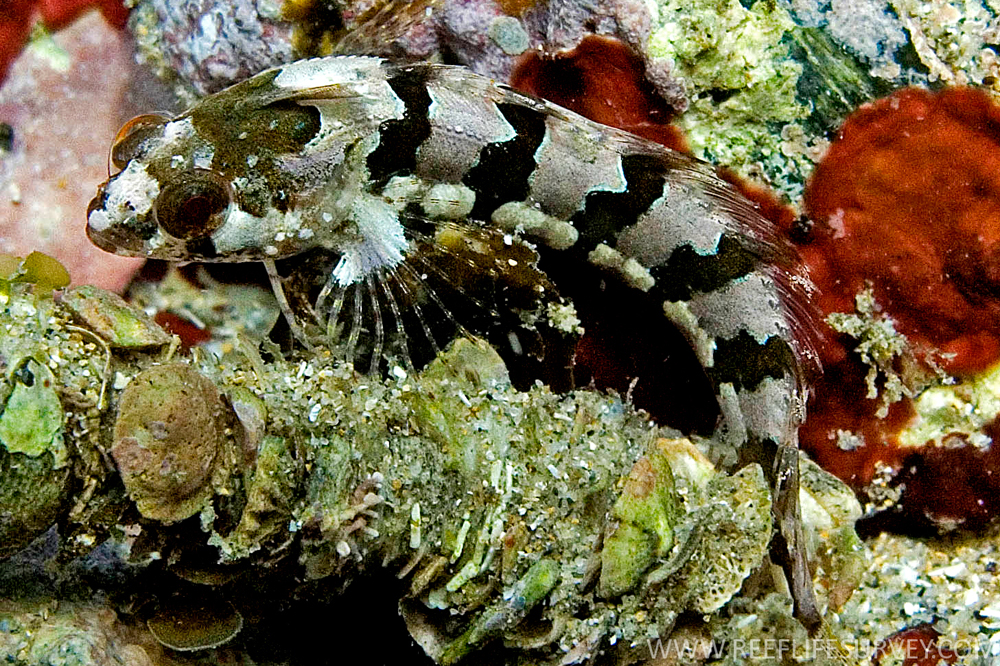- Classification
- ACTINOPTERYGII
- PERCIFORMES
- CLINIDAE
- Heteroclinus
- whiteleggii
Banded Weedfish, Heteroclinus whiteleggii (Ogilby 1894)

A Banded Weedfish, Heteroclinus whiteleggii, at Guerilla Bay, Batemans Marine Park, New South Wales. Source: Andrew J. Green / Reef Life Survey. License: CC By Attribution
Banded Weedfish, Heteroclinus whiteleggii (Ogilby 1894)
More Info
|
Distribution |
Endemic to eastern Australia, from Double Island Point, Queensland, to the Betka River mouth, eastern Victoria. Inhabits shallow sheltered and exposed algal-covered reefs, tidepools, and rock platforms. |
|
Features |
Dorsal fin III + XXVI-XXVIII, 3-4; Anal fin II, 18-22; Caudal fin (segmented rays) 10-12; Pectoral fin 11-13; Pelvic fin I, 3; Lateral line scales 20-26 + 22-23. Body compressed; tentacle above eye short, broad; nasal tentacle small, weakly lobed. Body covered in tiny cycloid scales; anterior portion of lateral line with a scale on each pore, posterior section with a scale between the pores. Dorsal fin in two parts, anterior section low, with membrane connecting long-based spinous second part, with 3-4 soft rays at end of fin; anal fin similar; pelvic fin-rays thickened, finger-like. |
|
Biology |
Clinids are viviparous, having internal fertilisation and birth of live young. |
|
Remarks |
Some authors treat Cristiceps fasciatus Macleay 1881 as a distinct species (Kuiter 1993; Kuiter & Kuiter 2018). |
|
Etymology |
The species is named for Ogilby's friend Mr Thomas Whitelegge, who found the type specimen "under stones between tidemarks on the oyster beds at Jervis Bay". |
|
Species Citation |
Clinus whiteleggii Ogilby, 1894, Proc. Linn. Soc. N. S. W. 2 9(2): 371. Type locality: Jervis Bay, New South Wales. |
|
Author |
Bray, D.J. 2022 |
|
Resources |
Banded Weedfish, Heteroclinus whiteleggii (Ogilby 1894)
References
Fricke, R., McEachran, J. & Williams, J.T. 2010. Heteroclinus whiteleggii. The IUCN Red List of Threatened Species 2010: e.T154943A4673560. http://dx.doi.org/10.2305/IUCN.UK.2010-4.RLTS.T154943A4673560.en. Downloaded on 10 January 2019.
Hutchins, J.B. & Swainston, R. 1986. Sea Fishes of Southern Australia. Complete field guide for anglers and divers. Perth : Swainston Publishing 180 pp.
Kuiter, R.H. 1993. Coastal Fishes of South-eastern Australia. Bathurst : Crawford House Press 437 pp. (as Heteroclinus fasciatus and H. whiteleggi)
Kuiter, R. & Kuiter, S. 2018. Coastal sea-fishes of south-eastern Australia. Seaford, Victoria : Aquatic Photographics, 371 pp. (as Heteroclinus fasciatus and H. whiteleggi)
Larson, H.K. 2001. Clinidae. pp. 3536-3537 in Carpenter, K.E. & Niem, T.H. (eds). The Living Marine Resources of the Western Central Pacific. FAO Species Identification Guide for Fisheries Purposes. Rome : FAO Vol. 6 pp. 3381-4218.
Macleay, W.J. 1881. Descriptive catalogue of the fishes of Australia. Part 3. Proceedings of the Linnean Society of New South Wales 1 6(1): 1-138 pls 1-2 (described as Cristiceps fasciatus) [a junior secondary homonym of Neoblennius fasciatus Castelnau]. See ref at BHL
McCulloch, A.R. 1908. Studies in Australian fishes, No. 1. Records of the Australian Museum 7(1): 36-43 pls 10-11 https://doi.org/10.3853/j.0067-1975.7.1908.949 (as Petraites fasciatus)
Ogilby, J.D. 1894. Description of five new fishes from the Australasian region. Proceedings of the Linnean Society of New South Wales 2 9(2): 367-374. See ref at BHL










